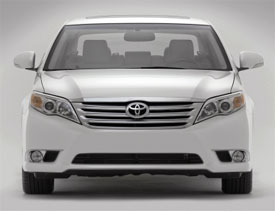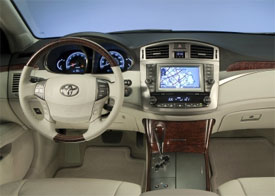2011 Toyota Avalon
There is no doubt that Toyota has had better years. Yet, months of bad publicity over recalls and bargain basement sales incentives have had little effect on their new product pipeline. Next out of the chute is a revamped Avalon, the Toyota brand’s flagship full-size sedan. With a bold new look, and even more attention to quality and safety, the 2011 Avalon sounds appealing. So, let’s see if the new Avalon makes happier headlines.
The Toyota Avalon first arrived for 1995 with upscale, conservative Chevrolet Caprice and Buick LeSabre buyers in its sights-buyers who didn’t want to pay for a pure luxury brand like Cadillac or Lexus. Avalon was redesigned for 2000, then again for 2005, each time becoming even more refined.
As the Avalon story continues for 2011, so do the improvements. But, competition these days comes from a growing field of more progressive premium sedans like the Buick LaCrosse, Ford Taurus, and just-released Hyundai Equus. Formerly available in three trims, the 2011 Avalon line-up has now been simplified to two: Base and Limited.
Still built on a Camry-based platform, the Avalon’s most obvious changes for this latest freshening are to exterior styling. Just below its broad hood is a wider, more present grille flanked by more elongated halogen headlamp housings. Our Limited included standard HID lighting with auto-leveling. The standard fog lamp design is also new.
 The Avalon’s substantial profile gets an extra shot of bright work with a chrome accent bar and door handles. Rocker panels have also been reshaped.
The Avalon’s substantial profile gets an extra shot of bright work with a chrome accent bar and door handles. Rocker panels have also been reshaped.
The rear also gets a tasteful tweaking with reshaped taillamps now using LED lighting. Down below are dual-exhaust pipes newly integrated into a trapezoidal cut-out. Standard Avalon wheels move from 16s to 17s, with our Limited flashing 10-spoke mirror-finished alloys.
A bigger transformation, however, happens inside the Avalon’s still spacious, technology-laden cabin. Virtually everything you see and touch is new, with a weighty style that uses premium materials and fabrics. We can’t say we’re in love with the busy dash, but the focal point-deep-set Optitron gauges-are easy for these old eyes to see.
Power leather-trimmed seats with front active headrests are standard. Support and comfort are both good. Our Limited added heating and cooling. The Limited also delivers a standard power rear sunshade and power moonroof. And there are seven airbags here, including one at the driver’s knees.
New standard technology includes Bluetooth, as well as USB and iPod connectivity. For the best listening experience, our Limited had an upgraded 12-speaker 660-watt JBL sound system. Toyota’s latest DVD navigation system with real-time traffic is optional, and includes the back-up camera image, which is otherwise seen in the rear-view mirror.
Second row seating is wide and roomy for three adults, and features larger headrests, as well as a segment-only recline feature for greater comfort. Unfortunately, these seats do not fold, and that’s a pretty big shortfall. However, a center-seat pass-thru leads back to a trunk with a usable 14.4 cubic feet of space.
The front-drive only Avalon still moves with a carryover 3.5-liter V6 rated at 268 horsepower and 248 pound-feet of torque. This more than adequate power is tied to a six-speed automatic with manual shift control.
 That powertrain makes Avalon one of the most efficient full-size sedans with Government Fuel Economy Ratings of 20 city/29 highway on regular gas. That’s better than V6 rivals. We managed 25.5 miles per gallon in real world driving.
That powertrain makes Avalon one of the most efficient full-size sedans with Government Fuel Economy Ratings of 20 city/29 highway on regular gas. That’s better than V6 rivals. We managed 25.5 miles per gallon in real world driving.
The Energy Impact Score for the Avalon is a moderate at 14.9 Barrels of Oil Consumed Per Year, with a matching Carbon Footprint of 8.1 Annual Tons of CO2 emitted.
Throttle down, the Avalon managed a 0 to 60 time of 6.9 seconds. That’s fine, if about a half second slower than our last Avalon test. The quarter mile passed in 15.2 seconds at 97 miles per hour. Unchanged are silky smooth revs and soft, seamless shifts.
Through the cones, the Avalon’s coil over strut suspension maintained a good line, even if the soft springs did allow quite a bit of push with gentle roll. At higher speeds, the car got a little twitchy, but still remained controllable. Steering is light but numb, and clearly optimized for a floatier feedback. And that speaks directly to the Avalon’s exceptionally smooth, Lexus-like street ride.
For stopping, the Avalon uses ABS disc brakes with Brake Assist. Hard 60-to-zeros averaged a longish 133 feet. There is some nose dive, but everything stayed razor straight.
Pricewise, the base Avalon starts at $33,005. While a high start for its class, it does include features, like dual zone automatic climate control, that others charge extra for. Limited trim starts at $36,245.
Regardless of Toyota’s recent woes, there is light at the end of the tunnel. And, the new Avalon is one source of that light. While it not may the most progressive big four-door you can buy, it continues to offer its fans a bullet-proof way to enjoy luxury motoring without overpaying.
Specifications
- Engine: 3.5-Liter V6
- Horsepower: 268
- Torque: 248 Lb Feet
- 0-60 MPH: 6.9 Seconds
- 1/4 Mile: 15.2 Seconds @ 97 MPH
- 60-0 MPH: 133 Feet
- EPA: 15 MPG City/ 21 MPG Highway
- Mixed Loop: 25.5 MPG
- Energy Impact 14.9 Barrels Oil/Yr:
- CO2 Emissions: 8.1 Tons/Yr






